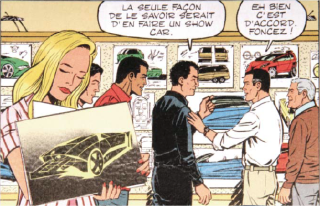- Manufacturer: Automobili Lamborghini S.p.A.
- Designer: Lamborghini Centro Stile
- Material: ABS
- www.lamborghini.com

Index
- Function A spoiler is an automotive aerodynamic device whose intended design function is to 'spoil' unfavorable air movement across a body of a vehicle in moti
- History The introduction of the car spoiler begin in the 1960s, when NASCAR automobiles still looked like what you drove on the street. In 1966, the Dodge Cha
- Streamline The interwar period was a time of changes throughout the world. The 1925 Paris exhibition, officially titled 'Exposition Internationale des Arts Décor
- Aerodynamics Aerodynamic efficiency of a car is determined by its Coefficient of Drag (Cd). Coefficient of drag is independent of area, it simply reflects the infl
- Designer Luc Donckerwolke is a Belgian citizen and was born on 19 June 1965 in Lima, Peru. He attended school in various South American and African countries b
- Bertone 'Making things by hand means addressing the cosmos, and you don't have to be an astronaut to know that this is the only way of life, of living togethe
- Reviews 'More aggressive and more elegant', Car and Driver 'Sexier than ever', Popular Mechanics 'Truly worthy', Motor Trend The 2009 Lamborghini Gallardo LP
- Status With cars, you wear your status on the road. Everyone knows which ones are the most expensive. (…) Of course, many people buy expensive cars (even if
- Testosterone According to a study published in the journal Organisational Behaviour and Human Decision Processes, driving a powerful vehicle can be beneficial to a
A spoiler is an automotive aerodynamic device whose intended design function is to 'spoil' unfavorable air movement across a body of a vehicle in motion
Position
The front spoiler, positioned low between the air intakes, improves aerodynamic equilibrium at high speeds.
Drag and Lift
Spoiler is the aerodynamic kit that alters the airflow underneath the car. We call those installed at the bottom edge of the front bumper a 'Chin Spoiler' or 'Air Dam', and those installed at the bottom edge of the car's sides as 'Skirt'.
[A] spoiler is used to reduce underside air flow by encouraging air to pass either side of the car. As a result, drag and lift caused by underside air flow could be reduced. Generally speaking, the lower the spoiler locates, the better the result obtained. Therefore you can see endurance racing cars having spoilers nearly touching the ground. Of course road cars cannot do so.
Speed
Front splitters [another name for spoilers] are further added to keep the nose of the car down. With an aerofoil on the rear, the car can have a tendency to lift at the front, so overlook the front aerodynamics at your peril. It should be noted that aerofoils and spoilers do not even start to have a noticeable effect until you hit speeds of 70mph. Up to this point they are a cause of drag and will rob you of fuel economy. Any car competing at speeds of 70mph or more should have its aerodynamic tuning fully sorted. It makes the car safer and will allow you to take the car's grip levels to unimaginable heights.
The introduction of the car spoiler begin in the 1960s, when NASCAR automobiles still looked like what you drove on the street. In 1966, the Dodge Charger had a flatter nose and a long, sloping roofline that seemed to make the car unstable and lift at higher speeds. NASCAR was petitioned and they allowed the Dodge teams to a piece of metal about one-half to two inches high to the rear decklid. This trapped air on the decklid and created downforce to stabilize the car. It did not make the Dodge a standout car, but other manufacturers did see the aerodynamic perk of adding something to the back of the car to increase downforce.
The Dodge Daytona debuted late in 1969 and [won] 2 of 4 big races it appeared it. The Daytona had a high wing and set new records. NASCAR has regulations as to what spoiler size and shape can be used on each track. These regulations are not popular with the drivers who think the cars are too loose, because of the lack of downforce the spoilers provide on the race car.
Spoilers for automobiles are confused with wings. Automotive wings are designed is to lessen the effect of drag by generating downforce as air passes around them and do not just disrupt the airflow patterns.

The interwar period was a time of changes throughout the world. The 1925 Paris exhibition, officially titled 'Exposition Internationale des Arts Décoratifs et Industriels Modernes', marked the starting point of the Art Deco movement. Influencing just about everything that had a design, the Art Deco revolution was first felt in Europe, but it rapidly caught on in the United States as well. Expressing mostly through visual and ornamental arts such as architecture and industrial design, it didn't pass long until it began to be found on cars also, but in another form: the Streamline Style.
Unlike the Art-Deco movement, which was mostly concerned with upward movement and angular geometric shapes, the Streamline Style was more curved and organic. Both styles were preoccupied with the 'movement' induced by the object they were representing, whether it was a static object, such as a building or a refrigerator, or whether it was moveable - such as an airplane, a train or, more importantly for our readers, a car.
Famous industrial designer Norman Bel Geddes wrote in 1932: 'An object is streamlined when its exterior surface is so designed that upon passing through a fluid such as water or air the object creates the least disturbance in the fluid.'
The most important work in the study of aerodynamics in the beginning of the century was conducted by Hungarian-born engineer Paul Jaray, who first started by completely redesigning the now-famous Zeppelins from looking like a tube to the streamline shapes we know today. He was born in Vienna in 1889, and after studying mechanical engineering he moved to the town of Zeppelins and Maybachs, Friedrichshafen.

Revolution in Car Design
Since 1912, [Paul Jaray] was actively involved in aerodynamics in every shape or form, but beside the dirigibles, his most famous work consists of the revolution he brought to car design. His first working prototype was announced as early as 8 of September 1921 with the request for a patent he made at the Berlin office for inventions.
'The lower part … has the form of a half streamline body and covers the chassis with the wheels, the engine compartment and the passenger compartment. The lower surface is even and runs parallel to the floor space. On this main part a substantially narrower streamline body is set, which is carried by a framework-like construction, which is developed on the chassis for its part,' is how Jaray's short description for the invention sounded.


Aerodynamic efficiency of a car is determined by its Coefficient of Drag (Cd). Coefficient of drag is independent of area, it simply reflects the influence to aerodynamic drag by the shape of the object. In theory, a circular flat plate has Cd 1.0, but after adding the turbulence effect around its edge, it becomes approximately 1.2. The most aerodynamic efficient shape is water drop, whose Cd is 0.05. However, we cannot make a car like this. A typical modern car is around Cd 0.30.
Luc Donckerwolke is a Belgian citizen and was born on 19 June 1965 in Lima, Peru. He attended school in various South American and African countries before going on to study Industrial Engineering in Brussels and Transportation Design in Vevey, Switzerland. In 1990 he began his career as a designer at Peugeot in France. Two years later he moved to Ingolstadt to Audi Design. From 1994 to 1996 he worked at the Skoda Design Center Mlada Boleslav in the Czech Republic. In 1996 he returned to Audi and was responsible for concept development at Audi Design for a year in Munich and a year in Ingolstadt.
Since 1998 Luc Donckerwolke has been working for Lamborghini in Sant´Agata, Italy, and has been Head of Design there since March 2003. Cars which bear his signature include the Audi A4 Avant, the Audi R8 Le Mans, the Skoda Octavia, the Skoda Fabia and the Lamborghini Gallardo. Luc Donckerwolke has received many awards for his work, the latest being the 'Red Dot Award' in 2003 for his Lamborghini models Gallardo and Murciélago. His hobbies include motor racing, old cars, foreign cultures and learning languages. He speaks Italian, French, Spanish, English, German, Flemish and Swahili.
Vaillant
[Donckerwolke] the much-travelled son of a diplomat recounts: 'As a child, I caught an African fever when we were in Burundi. As a get-well-soon present my father gave me a Michel Vaillant comic book, which immediately captivated me. That was the moment I started drawing cars.' The regularity with which new Vaillant volumes appeared each year was one of the few constants in a youth dominated by frequent moves. Little Luc soon knew his vocation: 'I definitely wanted to be a car designer.'
The comic fan of course had to visit compatriot and Michel Vaillant creator Jean Graton in Brussels, who created the first volume with its realistic-looking cars and motor-racing VIPs as long ago as 1957. 'That was in 1990.' Recalls 'Lucky Luc', 'and ever since then I've been drawing racing cars and fantasy sports cars with the Vaillant 'V' on the front for the comic-book series purely as a hobby.' [...]
Even Donckerwolke himself secures a bit-part role in the comic strip: at the design studio of the fictional sports car manufacturer Vaillante, he can be seen discussing the latest car designs with racing driver Michel, his older brother and company boss Jean-Pierre and company founder Henri Vaillant.

'Making things by hand means addressing the cosmos, and you don't have to be an astronaut to know that this is the only way of life, of living together on this planet, of creating something meaningful.'
The Italian design and coachbuilding firm known today as Carrozzeria Bertone dates to 1912, the year Giovanni Bertone set up a carriage building and repair facility in Turin. Two years later, a son was born to the Bertone household, a son who would have a major impact on the world of automotive design. He was Born in Turin on July 4, 1912.
However, Giuseppe 'Nuccio' Bertone was not a designer, though he claimed to have styled a number of one-off cars in his early years with the family company. But the drawings, he said, were lost in a fire during World War II. Giuseppe Bertone was nicknamed Nuccio. His father Giovanni founded Carrozzeria Bertone in 1914 after working as a carriage wheel-maker. Nuccio entered the family business while in his early twenties. Step-by-step, he transformed the small family workshop into a manufacturer of prototypes with an integrated design house. The company he built was able to assist car manufacturers with styling, models, engineering, prototype construction and production of up to 20,000 cars a year.
Nuccio Bertone, then 20, joined his father's business in 1934, the year the firm exhibited its special-bodied Fiat Ardita, the Superaerodinimica, at the Turin Auto Show. In the years following World War II, Nuccio Bertone raced Fiats, OSCAs, Maseratis, and Ferraris, an activity that taught him much about aerodynamics, cooling, and vehicle dynamics. At the 1952 Turin Auto Show, Bertone reached agreement with Chicago auto dealer Stanley Arnolt II to build 200 special-bodied MGs for sale in the U.S. Here the shape of the Bertone firm was determined: a combination of design and coachbuilding. [...]
The end of the 60s saw the beginning of the partnership with Ferruccio Lamborghini that was destined to make history in the car world. The first vehicle to come out of this was the Miura, presented at the 1966 Geneva Motor Show, which reinvented the design concept of a high performance coupé.
'More aggressive and more elegant', Car and Driver
'Sexier than ever', Popular Mechanics
'Truly worthy', Motor Trend
The 2009 Lamborghini Gallardo LP560-4 gives auto writers from across the Web—and the editors of TheCarConnection.com—the chance to exercise some vocabulary to describe its fantastic, outrageous shape.
The 'first model completely designed under the watchful and sensible eye of Audi,' Motor Authority reports, the newest version of the Gallardo is 'more in to line with the Murcielago and recent Reventon concept. You can clearly see the family resemblance in the new model with giant air dams and new lights in the front.' It's 'more aggressive and more elegant than before,' Car and Driver says, with 'a bit more of a chin ... LED daytime running lights,' and 'smoothed and filled' body surfaces that replace the 'dozens of gills on the original Gallardo.' Motor Trend exclaims, 'Behind the cosmetically reshaped nose, between the all new Y-styled, LED head and taillights, is a vehicle truly worthy of such an affected alphanumeric name.' It's plainly 'sexier than ever,' Popular Mechanics says succinctly.
The 2009 Gallardo's cabin sports 'a purposeful cabin that can be outfitted with leather, Alcantara or carbon-fiber accents,' Popular Mechanics says. 'The familiar Audi-sourced nav system and A/C controls are easy to use, and the tach's 8500 rpm redline is one of the few clues to the outrageous side of this Lambo's personality.'
The 2009 Lamborghini Gallardo LP560-4 cuts a distinctive shape in the atmosphere, and suits driver and passenger with a purposeful interior.
With cars, you wear your status on the road. Everyone knows which ones are the most expensive. (…) Of course, many people buy expensive cars (even if they can't afford it) just to show-off or project an image or wealth or importance. For Sam Walton, founder of Wal-Mart, he preferred practical over showy. He commented on his choice of vehicle: 'Why do I drive a pickup truck? What am I supposed to haul my dogs around in, a Rolls-Royce?'
According to a study published in the journal Organisational Behaviour and Human Decision Processes, driving a powerful vehicle can be beneficial to a man's health by helping them produce more testosterone. Driving a clapped-out old banger, meanwhile, had the opposite affect, sending levels down, researchers from Concordia University in Montreal found.

































































































